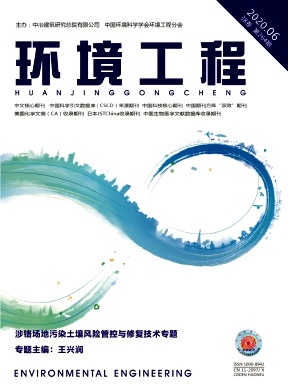|
LI Y Y, LIANG J L, YANG Z H, et al. Reduction and immobilization of hexavalent chromium in chromite ore processing residue using amorphous FeS2[J]. Science of the Total Environment, 2019, 658: 315-323.
|
|
陈滨宇. 解毒铬渣堆放场周围环境铬污染规律研究[J]. 环境科学与技术, 1989, 47(4): 8-10.
|
|
WAZNE M, JAGUPILLA S C, MOON D H, et al. Assessment of calcium polysulfifide for the remediation of hexavalent chromium in chromite ore processing residue (COPR)[J]. Journal of Hazardous Materials, 2007, 143(3): 620-628.
|
|
MOON D H, WAZNE M, DERMATAS D, et al. Long-term treatment issues with hromite ore processing residue (COPR): Cr6+ reduction and heave [J]. Journal of Hazardous Materials, 2007, 143(3): 629-635.
|
|
荣伟英, 周启星. 铬渣堆放场地土壤的污染过程、影响因素及植物修复[J]. 生态学杂志, 2010, 29(3): 598-604.
|
|
DERMATAS D, CHRYSOCHOOU M, MOON D H, et al. Ettringite-induced heave in hromite ore processing residue (COPR) upon ferrous sulfate treatment[J]. Environmental Science & Echnology, 2006, 40(18): 5786-5792.
|
|
盛灿文, 柴立元, 王云燕,等. 铬渣的湿法解毒研究现状及发展前景[J]. 工业安全与环保, 2006, 32(2): 1-3.
|
|
LI Y Y, CUNDY A B, FENG J X, et al. Remediation of hexavalent chromium contamination in chromite ore processing residue by sodium dithionite and sodium phosphate addition and its mechanism[J]. Journal of Environmental Management, 2017, 192: 100-106.
|
|
JAGUPILLA S C, WAZNE M, MOON D H. Assessment of ferrous chloride and Portland cement for the remediation of chromite ore processing residue[J]. Chemosphere, 2015, 136: 95-101.
|
|
GEELHOED J S, MEEUSSEN J C N, ROE M J, et al. Effect of iron(Ⅱ) sulfate addition on chromium(Ⅵ) leaching from columns of chromite ore processing residue[J]. Environmental Science & Technology, 2003, 37(14): 3206-3213.
|
|
JAGUPILLA S C, MOONA D H, WAZNE M, et al. Effects of particle size and acid addition on the remediation of chromite ore processing residue using ferrous sulfate[J]. Journal of Hazardous Materials, 2009, 168: 121-128.
|
|
宋艳, 杨志平, 康绍辉,等. 铬渣中Cr(Ⅵ)的浸出及还原试验研究[J]. 湿法冶金, 2017, 36(5):380-383.
|
|
斯塔姆W, 摩尔根J. 水化学: 天然水体化学平衡导论[M]. 汤鸿霄,译. 北京:科学出版社, 1987, 129-134.
|
|
JAGANYI D, WHEELER P J. Rooibos tea: equilibrium and extraction kinetics of aspalathin[J]. Food Chemistry, 2003, 83: 121-126.
|
|
刘帅霞. 两段式还原工艺解毒铬渣技术研究[D]. 上海:东华大学, 2013.
|
|
MATERN K, KLETTI H, MANSFELDT T. Chemical and mineralogical characterization of chromite ore processing residue from two recent Indian disposal sites[J]. Chemosphere, 2016, 155: 188-195.
|
|
YAO S, JING L, MIAO P, et al. Identification of Cr(Ⅵ) speciation in ferrous sulfate-reduced chromite ore processing residue (rCOPR) and impacts of environmental factors erosion on Cr(Ⅵ) leaching [J]. Journal of Hazardous Materials, 2019, 373: 389-396.
|
|
CHRYSOCHOOU M, DERMATAS D. Application of the Rietveld method to assess chromium(Ⅵ) speciation in chromite ore processing residue[J]. Journal of Hazardous Materials, 2007, 141(2): 370-377.
|
|
GUO B, SASAKI K, HIRAJIMA T, et al. Selenite and selenate uptaken in ettringite: immobilization mechanisms, coordination chemistry, and insights from structure[J]. Cement Concrete Research, 2017, 100: 166-175.
|
|
PAPASSIOPI N, VAXEVANIDOU K, CHRISTOU C, et al. Synthesis, characterization and stability of Cr(Ⅲ) and Fe(Ⅲ) hydroxides[J]. Journal of Hazardous Materials, 2014, 264: 490-497.
|
|
MILLS C T, BERN C R, WOLF R E, et al. Modifications to EPA method 3060A to improve extraction of Cr(Ⅵ) from chromium ore processing residue-contaminated soils[J]. Enviromental Science & Technology, 2017, 51(19): 11235-11243.
|
|
KARAMALIDIS A K, VOUDRIAS E A. Anion leaching from refinery oily sludge and ash from incineration of oily sludge stabilized/solidified with cement[J]. Environmental Science & Technology, 2008, 42(16): 6124-6130.
|
|
GLASSER F P. Fundamental aspects of cement solidification and stabilisation[J]. Journal of Hazardous Materials, 1997, 52(2/3): 151-170.
|
|
HILLIER S, ROE M J, GEELHOED J S, et al. Role of quantitative mineralogical analysis in the investigation of sites contaminated by chromite ore processing residue[J]. Science of the Total Environment, 2003, 308(1/2/3): 195-210.
|
|
WU J N, LI C L, YANG F. The disposition of chromite ore processing residue (COPR) incorporating industrial symbiosis[J]. Journal of Cleaner Production, 2015, 95: 156-162.
|
|
TINJUM J M, BENSON C H, EDIL T B. Mobilization of Cr(Ⅵ) from chromite ore processing residue through acid treatment[J]. The Science of the Total Environment, 2008, 391(1): 13-25.
|
|
VELASCO A, RAMÍREZ M, HERNÁNDEZ S, et al. Pilot scale treatment of chromite ore processing residue using sodium sulfide in single reduction and coupled reduction/stabilization processes[J]. Journal of Hazardous Materials, 2012, 207/208: 97-102.
|
|
YANG H S, CHE Y J, LENG F G. Calcium leaching behavior of cementitious materials in hydrochloric acid solution[J]. Scientific Reports, 2018, UK 8.
|
|
WAZNE M, JAGUPILLA S C, MOON D H, et al. Leaching mechanisms of Cr(Ⅵ) from chromite ore processing residue[J]. Journal of Environmental Quality, 2008, 37(6): 2125-2134.
|
|
CHRYSOCHOOU M, FAKRA S C, MARCUS M A, et al. Microstructural analyses of Cr(Ⅵ) speciation in chromite ore processing residue (COPR)[J]. Environmental Science & Technology, 2009, 43(14): 5461-5466.
|
|
MOON D H, WAZNE M, DERMATAS D, et al. Evaluation of ettringite-related swelling mechanisms for treated chromite ore processing residue[J]. Environmental Science and Pollution Research International, 2015, 22(1): 738-744.
|
|
徐文彬.铬渣解毒与氧化铬清洁制备工艺的研究[D].长沙:中南大学,2011.
|
|
PALMER C D, WITTBRODT P R. Processes affecting the remediation of chromium-contaminated sites[J]. Environmental Health Perspectives, 1991, 92: 25-40.
|
|
WANG X, ZHANG J D, WANG L L, et al. Long-term stability of FeSO4 and H2SO4 treated chromite ore processing residue (COPR): importance of H+ and SO42-[J]. Journal of Hazardous Materials, 2017, 321: 720-727.
|


 Login
Login Register
Register E-alert
E-alert






 DownLoad:
DownLoad: